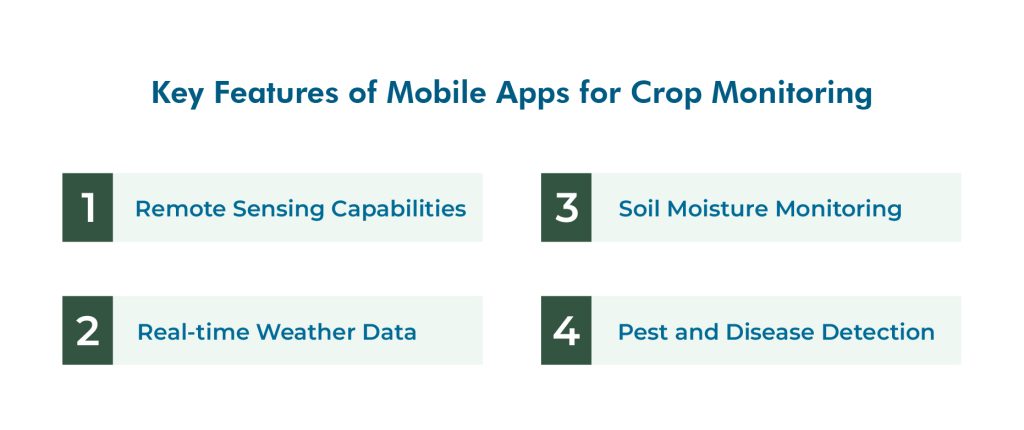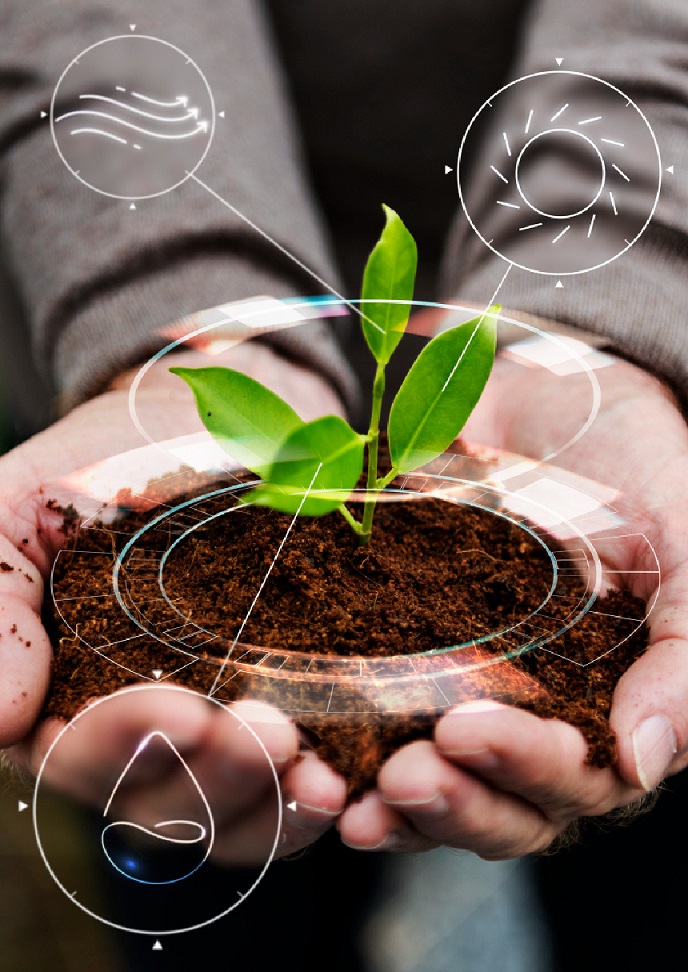BLOG
Leveraging Mobile Apps for Precision Agriculture and Crop Monitoring
There was a time when technology and agriculture were like oil and water, but not anymore! Technology is revolutionizing every industry, and agriculture is no exception.
The report shows that the global market size of smart agriculture is expected to grow from approximately 12.4 billion U.S. dollars in 2020 to 34.1 billion U.S. dollars by 2026.
The emergence of mobile applications has brought about a new era of data-driven farming. It has enabled farmers to make informed decisions and optimize their operations like never before.
Agriculture has changed and evolved now. Climate change, soil erosion, fertilizer-induced mineral depletion, and water levels going down have impacted agriculture drastically.
As the problems are interlinked it requires some radical measures to resolve them. This is where technology comes to the rescue and helps farmers fix the issues effectively and advance farming techniques.
In this blog post, we will explore how mobile apps are transforming agriculture, particularly for small and medium-sized agricultural firms.
We will delve into the concept of precision agriculture. The benefits of using mobile apps for crop monitoring. And how these apps can help agri firms achieve higher productivity, efficiency, and sustainability.

Understanding Precision Agriculture:
Precision agriculture leverages technology, data analytics, and connectivity to optimize resource utilization, reduce costs, and improve crop yields.
It involves the collection, analysis, and interpretation of data to make precise decisions regarding farming, including irrigation, fertilization, and pest management.
The Role of Mobile Apps in Precision Agriculture:
Mobile apps play a pivotal role in precision agriculture by providing a user-friendly interface to collect and analyse data.
Apps connect sensors, IoT devices, and drones to collect data on soil moisture, weather conditions, crop growth, and pest infestations.
It instantly processes, analyses, and presents data in a simpler format and takes timely action to optimize its farming process.
Table of Content
- Flutter Vs React Native: Choosing The Right Framework For Your Mobile App
- Introduction To Flutter: Unleashing Cross-Platform App Development
- Mobile App Development Process: 10 Mistakes To Avoid
- Accelerating Change: The Impact Of Mobile Applications On The Automotive Sector
- Full-Stack: The Key To Building Scalable And Agile Businesses
- A Step-By-Step Guide To Mobile App Development Process: Part 1
- A Step-By-Step Guide To Mobile App Development Part 2
- Mobile App Development: Unlocking The Power Of Technology For The Modern World
- 14 Must-Have Features For A Successful Mobile App In 2023
- The Ultimate Guide To UI/UX Transformation And Its Benefits For Businesses
Key Features of Mobile Apps for Crop Monitoring:
Mobile apps designed are equipped with a range of features that aid in seamless data collection and analysis. These features include:
Remote Sensing Capabilities
Mobile apps integrate with satellite imagery and drone-based aerial surveys, and provide detailed insights into crop health, growth patterns, and field variability. It enables farmers to detect issues like nutrient deficiencies, disease outbreaks, or weed infestations early on.
Real-time Weather Data
Access to real-time weather data helps farmers take action regarding irrigation, pesticide application, and harvesting schedules. By aligning their farming activities with weather patterns, farmers can optimize resource utilization and reduce the risk of crop damage.
Soil Moisture Monitoring
Mobile apps allow farmers to monitor soil moisture levels accurately, enabling them to adjust irrigation schedules based on actual crop requirements. This ensures that crops receive adequate moisture without wasting water resources.
Pest and Disease Detection
Mobile apps incorporate image recognition technology to identify pests and diseases affecting crops. Farmers can quickly identify and address these issues, preventing their spread and minimizing the need for extensive chemical treatments.

Benefits of Mobile App-Based Crop Monitoring:
Mobile app-based crop monitoring offers several significant benefits for small and medium-sized agri firms:
Early Detection and Intervention
By monitoring crops in real time, farmers can detect early signs of stress, nutrient deficiencies, or disease outbreaks. Timely intervention allows for proactive measures to be taken, reducing the risk of crop loss, and increasing overall yield.
Optimal Resource Utilization
With access to accurate data on soil moisture, weather conditions, and crop growth patterns, farmers can optimize resource allocation, including water, fertilizers, and pesticides. This leads to cost savings and reduces environmental impact.
Improved Decision-Making
Mobile apps provide farmers with data-driven insights and actionable recommendations. Farmers can mitigate risks, maximize productivity, and achieve better overall farm management.
Enhanced Efficiency and Time Savings
Mobile apps streamline data collection and analysis, eliminating the need for manual record-keeping and data entry. This not only saves time but also reduces the chances of errors or discrepancies in data management. Farmers can focus more on their core farming activities, leading to increased operational efficiency.
Better Sustainability Practices
Mobile app-based crop monitoring enables farmers to implement sustainable farming practices. By optimizing resource utilization, minimizing chemical inputs, and reducing water wastage, farmers can contribute sustainable agricultural practices.
Increased Profitability
By leveraging mobile apps agri firms can achieve higher crop yields, reduce production costs, and improve overall farm profitability. With better decision-making and optimized resource allocation, farmers can maximize their return on investment.
Considerations for Selecting Mobile App Services:
When selecting a mobile app service provider for crop monitoring, agri firms should consider the following factors:
App Functionality: Ensure that the mobile app provides the necessary features and functionalities tailored to your specific crop monitoring requirements.
Compatibility: Mobile app should be compatible with existing farm management systems and should integrate with other devices on your farm.
User Interface: A user-friendly interface is crucial for farmers to easily navigate the app and interpret data effectively. Look for intuitive designs and easy-to-understand visualizations.
Data Security: Choose a mobile app service provider that prioritizes data security and implements robust measures to protect data.
Scalability: Consider whether the mobile app can accommodate your future needs as your farm expands or requirements evolve.
Technical Support: Ensure that the service provider offers ongoing technical support to address any issues or new feature requirements.
Overcoming Challenges and Adoption Strategies:
While mobile app-based crop monitoring offers numerous benefits, agri firms may encounter challenges during implementation. Some common challenges include:
Connectivity: Ensure that reliable internet connectivity is available on your farm or explore options for offline data collection.
Training: Provide training and support to your farm staff to familiarize them with the mobile app’s functionality.
Gradual Implementation: Start with a small-scale implementation to test the app’s effectiveness and gradually expand its usage across your farm.
Collaboration and Knowledge-Sharing: Engage with industry peers, agricultural extension services, and research institutions to learn from their experiences.

Future Trends to Consider:
The future of mobile app-based agriculture holds exciting possibilities. Emerging trends and innovations to watch out for include:
Artificial Intelligence (AI) and Machine Learning (ML)
AI and ML technologies have the potential to enhance mobile app-based agriculture further. These technologies can analyse large datasets, identify patterns, and provide more accurate predictions and recommendations for crop management.
Blockchain Technology
Blockchain has the potential to revolutionize data management and traceability in agriculture. It can ensure the integrity and transparency of agricultural data, enabling farmers to track the entire supply chain, from seed to market.
Internet of Things (IoT) Integration
The integration of IoT devices with mobile apps allows for real-time monitoring of various environmental factors, such as soil moisture, temperature, and air quality. This integration provides more comprehensive data for precise decision-making.
Advanced Imaging Techniques
Mobile apps can leverage advanced imaging techniques, such as hyperspectral imaging and thermal imaging, to capture detailed information about crop health, stress levels, and water distribution within fields.
Predictive Analytics
Mobile apps can utilize predictive analytics algorithms to forecast crop yields, disease outbreaks, and market trends. This helps farmers make proactive decisions and optimize their production and marketing strategies.
Conclusion:
Mobile apps are transforming agriculture by enabling precision agriculture and data-driven farming practices. For small and medium-sized agricultural firms in the United States, leveraging mobile app-based crop monitoring can lead to higher productivity, improved resource efficiency, and enhanced sustainability.
By adopting mobile apps tailored to their crop monitoring needs, agri firms can benefit from early detection of crop issues, optimal resource utilization, and better decision-making.
However, careful considerations must be made when selecting mobile app services, considering functionality, compatibility, user interface, data security, scalability, and technical support.
Overcoming challenges through proper training, gradual implementation, and collaboration with industry peers is essential for successful adoption.
As the agricultural industry evolves, future trends such as AI and ML, blockchain technology, IoT integration, advanced imaging techniques, and predictive analytics will shape the landscape of mobile app-based agriculture.
By embracing these advancements, agri firms can stay at the forefront of innovation and drive sustainable growth in the agricultural sector.
Related Topics
Trending Topics
Want to build Super app for your business?



